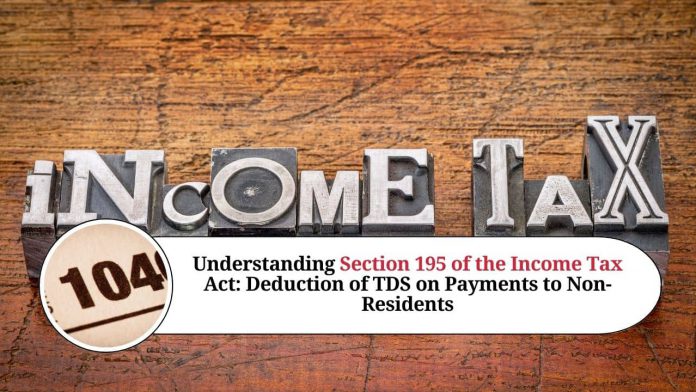Section 195 of the Income Tax Act, 1961, lays down the provisions related to the deduction of tax at source (TDS) on payments made to non-residents. The section applies to any person responsible for paying any sum chargeable to tax to a non-resident or a foreign company.
The primary objective of Section 195 is to ensure that non-residents pay tax on the income they earn in India. Since non-residents are not subject to regular TDS provisions, this section requires the person making payments to them to deduct tax at source and deposit it with the Income Tax Department.
Let’s take a closer look at some of the key provisions of Section 195.
Applicability: Section 195 applies to all non-residents, including foreign companies, who earn income in India. The section also applies to Indian residents making payments to non-residents.
Rate of TDS: The TDS rate for payments made to non-residents depends on the nature of the payment. The rates for TDS on payments to non-residents are generally higher than those applicable to Indian residents.
The TDS rates for various payments to non-residents are specified under Section 195, and they range from 10% to 40%. The exact rate of TDS depends on the type of income, the residency status of the non-resident, and any applicable tax treaty between India and the non-resident’s country of residence.
Exemptions: There are some exemptions provided under Section 195. For example, if the non-resident has obtained a certificate from the tax authorities stating that their income is not taxable in India, no TDS needs to be deducted.
Similarly, if the non-resident has applied for and obtained a lower TDS rate under a tax treaty, the TDS rate can be lower than the prescribed rate.
Compliance requirements: The person responsible for making the payment to the non-resident is required to obtain a Tax Deduction Account Number (TAN) and deduct TDS at the applicable rate. The TDS deducted must be deposited with the government within the specified due dates.
Additionally, the person responsible for making the payment is required to file TDS returns and provide a TDS certificate to the non-resident. Failure to comply with these provisions can result in penalties and interest.
Scope of Section 195:
Section 195 applies to any sum chargeable to tax under the Income Tax Act that is payable to a non-resident or a foreign company. The section applies to all types of payments, including interest, royalty, fees for technical services, and other forms of income.
For example, if an Indian company pays royalties to a foreign company for the use of its technology or trademark, the Indian company is required to deduct TDS under Section 195. Similarly, if an Indian resident pays interest to a non-resident for a loan taken from them, TDS must be deducted under this section.
TDS Rates:
As mentioned earlier, the TDS rate under Section 195 depends on the nature of the payment and the residency status of the non-resident. The TDS rates for various types of payments are specified in the Income Tax Act or the tax treaty between India and the non-resident’s country of residence.
For example, the TDS rate for interest paid to a non-resident is 20%, while the TDS rate for royalty payments can range from 10% to 40%. However, if a tax treaty between India and the non-resident’s country of residence provides for a lower rate of TDS, the lower rate can be applied.
Exemptions:
Section 195 provides for certain exemptions from TDS. For example, if the non-resident has obtained a certificate from the tax authorities stating that their income is not taxable in India, no TDS needs to be deducted.
Similarly, if the non-resident has applied for and obtained a lower TDS rate under a tax treaty, the lower rate can be applied. However, to claim these exemptions, the non-resident must provide the necessary documents to the person responsible for deducting TDS.
Compliance requirements:
The person responsible for deducting TDS under Section 195 is required to obtain a Tax Deduction Account Number (TAN) and deduct TDS at the applicable rate. The TDS deducted must be deposited with the government within the specified due dates.
The person responsible for making the payment is also required to file TDS returns and provide a TDS certificate to the non-resident. Failure to comply with these requirements can result in penalties and interest.
Conclusion:
Section 195 is a crucial provision of the Income Tax Act that ensures non-residents pay tax on the income they earn in India. It is essential for taxpayers to understand the provisions of this section and comply with the requirements to avoid any penalties or interest.
Read Other Useful Blogs:
It is advisable to seek professional guidance to understand the nuances of Section 195 and comply with the law. Additionally, the Indian tax authorities have been focusing on enforcing compliance with TDS provisions, and non-compliance can result in severe consequences.
Frequently Asked Questions (FAQs)
Q. What is Section 195 of the Income Tax Act?
Answer: Section 195 of the Income Tax Act deals with the deduction of tax at source (TDS) on payments made to non-residents. The section aims to ensure that non-residents pay tax on the income they earn in India.
Q. Who is liable to deduct TDS under Section 195?
Answer: Any person responsible for paying any sum chargeable to tax to a non-resident or a foreign company is liable to deduct TDS under Section 195.
Q. What types of payments are covered under Section 195?
Answer: Section 195 applies to all types of payments made to non-residents, including interest, royalty, fees for technical services, and other forms of income.
Q. What is the TDS rate under Section 195?
Answer: The TDS rate under Section 195 varies depending on the nature of the payment and the residency status of the non-resident. The rates range from 10% to 40%. However, if a tax treaty between India and the non-resident’s country of residence provides for a lower rate of TDS, the lower rate can be applied.
Q. Are there any exemptions from TDS under Section 195?
Answer: Yes, there are some exemptions from TDS under Section 195. For example, if the non-resident has obtained a certificate from the tax authorities stating that their income is not taxable in India, no TDS needs to be deducted. Similarly, if the non-resident has applied for and obtained a lower TDS rate under a tax treaty, the lower rate can be applied.
Q. What are the compliance requirements under Section 195?
Answer: The person responsible for deducting TDS under Section 195 is required to obtain a Tax Deduction Account Number (TAN) and deduct TDS at the applicable rate. The TDS deducted must be deposited with the government within the specified due dates. The person responsible for making the payment is also required to file TDS returns and provide a TDS certificate to the non-resident.
Q. What are the consequences of non-compliance with Section 195?
Answer: Failure to comply with the provisions of Section 195 can result in penalties and interest. The Indian tax authorities have been focusing on enforcing compliance with TDS provisions, and non-compliance can result in severe consequences.





















